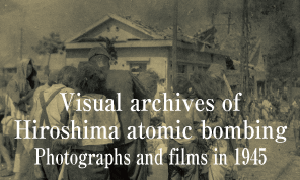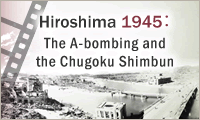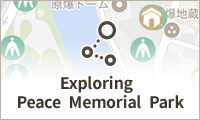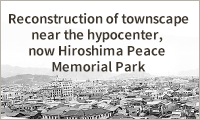Documenting Hiroshima 80 years after A-bombing: May 5, 1958, Children’s Peace Monument unveiled
Mar. 31, 2025
Classmates had hoped to create “grave marker for Sadako”
by Minami Yamashita, Staff Writer
On May 5, 1958, the Children’s Peace Monument was unveiled at Peace Memorial Park (in Hiroshima City’s present-day Naka Ward). The monument was modeled on Sadako Sasaki, a young girl who had died of leukemia at the age of 12. The first-year high-school student Tomiko Kawano, 82, now a resident of the city’s Naka Ward who had been Ms. Sasaki’s classmate in the sixth-grade “bamboo class” at Noboricho Elementary School (also in Naka Ward), joined in the applause at the ceremony with a sense of fulfilment. “I was motivated by the sole purpose of keeping a promise we had made to Sadako at her grave,” said Ms. Kawano.
The monument is composed of a bronze statue (around three meters tall) of a young girl holding a paper crane in both hands over her head, standing on a concrete base (measuring roughly six meters in height). The Nobel Prize-winning physicist Hideki Yukawa donated the bell for the monument, on which are written his words, “One-thousand Paper Cranes” and “Peace on Earth and in the Heavens.”
The monument’s inscription was selected from among proposals publicly submitted by junior high school students — “This is our cry. This is our prayer. For building peace in this world.”
2,000 flyers printed
The impetus behind establishment of the monument was prompted by a group of Sadako’s classmates at elementary school, who by then were studying at Noboricho Junior High School and elsewhere. In November 1955, 14 days after Sadako’s death, the group came up with an idea of a grave marker for Sadako when they were gathered together to attend her memorial service, out of remorse for not having visited her frequently enough while she was hospitalized.
However, Ichiro Kawamoto, 26 at the time, who was also present at the meeting, recommended they work on building a memorial monument for all children who were killed in the atomic bombing. They agreed to the proposal as group and began to raise funds for the project.
Calling themselves, as the promoter of the campaign, “First-year students at Noboricho Junior High School in Hiroshima, a group of classmates of the late Sadako Sasaki,” they printed 2,000 flyers seeking donations. On the flyers were written the sentiments, ‘Toward creating a monument for children of the atomic bombing’ and ‘Our hope is to enshrine the souls of children who died of the atomic bombing.’ After the flyers were distributed at a meeting of the Japan National Association of School Principals, held in Hiroshima City in November of that year, donations began to be sent to Noboricho Junior High School from throughout Japan.
An association of children and students in Hiroshima designed to create peace was formed of student councils at schools in Hiroshima City, with that group leading the effort to create a monument. The group of Sadako’s elementary school classmates also joined the efforts, which was reported in newspapers and on the radio, but Ms. Kawano had mixed feelings.
“I hated holding Sadako’s portrait and standing on the street for the campaign, because it felt like marketing. I can understand the purpose now, but back then, I was sad that the activity seemed to elude our control the larger it had become.”
Spending three years on monument
Despite that, when the members of her group met, they would offer each other encouragement, remarking “let’s do it for Sadako.” The spent their three years in junior high school on the campaign. Donations from Japan and overseas ultimately reached around 5.8 million yen. Alongside the monument’s statue of the young girl holding the paper crane were added two statues of a boy and a girl. Ms. Kawano said, “I think those statues represent us.”
The story of Sadako and her paper cranes spread around the world. One reason behind the popularity was the book Haikyo no Hikari (in English, “Children of the Ashes”), published in 1959. Mr. Kawamoto had shared Sadako’s story with the book’s author, Robert Jungk, an international journalist from Germany who was on a visit to Hiroshima. Mr. Kawamoto would go on to support the children’s peace movement as a facilitator of the Hiroshima Paper Crane Club, established in June 1958.
(Originally published on March 31, 2025)








